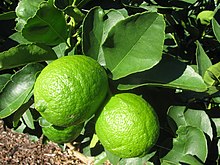Persian lime (Citrus × latifolia), also known by other common names such as seedless lime,[2] Bearss lime[3] and Tahiti lime,[3] is a citrus fruit species of hybrid origin, known only in cultivation.[2] The Persian lime is a triploid cross between Key lime (Citrus × aurantiifolia) and lemon (Citrus × limon).[4][5]
| Persian lime | |
|---|---|

| |
| Limes on the tree | |
| Scientific classification | |
| Kingdom: | Plantae |
| Clade: | Tracheophytes |
| Clade: | Angiosperms |
| Clade: | Eudicots |
| Clade: | Rosids |
| Order: | Sapindales |
| Family: | Rutaceae |
| Genus: | Citrus |
| Species: | C. × latifolia
|
| Binomial name | |
| Citrus × latifolia (Yu.Tanaka) Yu.Tanaka
| |
| Synonyms[1][2] | |
| |
Although there are other citrus species that are referred to as "limes", the Persian lime is the most widely cultivated lime species commercially,[6] and accounts for the largest share of the fruits sold as limes. The fruit turns yellow as it ripens, but it is universally sold while still green.
Description
editThe tree is nearly thornless. The fruit is about 6 centimetres (2+1⁄2 inches) in diameter, often with slightly nippled ends, and is usually sold while green, although it yellows as it reaches full ripeness. It is larger, thicker-skinned, with less intense citrus aromatics than the Key lime (Citrus aurantifolia). The advantages of the Persian lime in commercial agriculture compared to the key lime are the larger size, absence of seeds, hardiness, absence of thorns on the bushes, and longer fruit shelf life. They are less acidic than key limes and do not have the bitterness that lends to the key lime's unique flavor.
Cultivation
editPersian limes were first grown on a large scale in Persia (now known as Iran) and southern Iraq.[7][8]
The trees are propagated clonally, by grafting or air layering.[9] Persian limes are commercialized primarily in six sizes, known as 110s, 150s, 175s, 200s, 230s and 250s. Large numbers of Persian limes are grown, processed, and exported every year primarily from Mexico[6] to the American, European and Asian markets. In 2014, Brazil was the major exporter of fresh limes to Europe (about 70%) with Mexico supplying most of the remainder.[10]
Cultivars
editCultivars include:
- Bearss lime[11] (named after John T. Bearss, who developed this seedless variety about 1895 in his nursery at Porterville, California)
- Page lime[12]
- Persian lime SPB-7[13]
- Pond's lime[14]
- Tahiti lime[15]
Uses
editIt is widely available dried, as it is often used this way in Persian cuisine.
References
edit- ^ Porcher, Michel H.; et al. (1995), Multilingual Multiscript Plant Name Database (M.M.P.N.D): Sorting Citrus Names, The University of Melbourne
- ^ a b c Dianxiang Zhang; David J. Mabberley, "21. Citrus Linnaeus, Sp. Pl. 2: 782. 1753", Flora of China Online, retrieved 30 June 2016
- ^ a b USDA GRIN Taxonomy, retrieved 30 June 2016
- ^ Curk, Franck; Ollitrault, Frédérique; Garcia-Lor, Andres; Luro, François; Navarro, Luis; Ollitrault, Patrick (2016). "Phylogenetic origin of limes and lemons revealed by cytoplasmic and nuclear markers". Annals of Botany. 11 (4): 565–583. doi:10.1093/aob/mcw005. PMC 4817432. PMID 26944784.
- ^ Ali, Muhammad Amjad; Nawaz, Muhammad Azher (2017), "Advances in Lime Breeding and Genetics", in Khan, M. Mumtaz; Al-Yahyai, Rashid; Al-Said, Fahad (eds.), The lime: botany, production and uses, CAB International, pp. 37–53
- ^ a b Perez, Agnes; Pollack, Susan (July 30, 2008). "Greater Imports of Mangoes and Lime for Most of 2008's First Half, Early 2008/09 Grape Imports Also Up" (PDF). Fruit and Tree Nuts Outlook (FTS-333). Economic Research Service, United States Department of Agriculture: 16.
- ^ Raichlen, Steven (August 2, 1992). "Small citruses yield tart juice, aromatic oils, big, fresh taste". The Baltimore Sun. Archived from the original on January 2, 2013. Retrieved 30 March 2012.
- ^ Lim, T. K. (2012-06-11). Edible Medicinal and Non-Medicinal Plants: Volume 4, Fruits. Springer. ISBN 9789400740532.
- ^ Jonathan H. Crane and Jason L. Osborne (2015), Growing 'Tahiti' Limes in the Home Landscape, University of Florida, IFAS Extension
- ^ CBI Product Factsheet: Fresh Limes in Europe
- ^ Bearss lime at Citrus Variety Collection Website
- ^ Page lime
- ^ Persian lime SPB-7
- ^ Pond's lime
- ^ Tahiti lime
External links
edit- Media related to Citrus latifolia at Wikimedia Commons
- Data related to Citrus latifolia at Wikispecies
- Tahiti lime botany, agriculture, and history